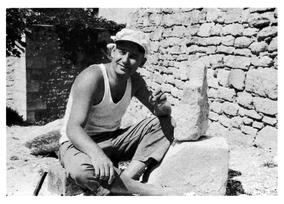Jan Křížek
1919 Born July 31st in Dobroměřice u Loun.
1938 He begins studying at the Academy of Fine Arts at the sculpture studio of Bohumil Kafka.
1939-1945 After completing his studies, he works with the stonecutter Otakar Velínský; he draws and educates himself in libraries, especially in the library of the Museum of Applied Arts. Almost every day he meets with Vaclav Boštík and together they concern themselves with questions of art.
1946 At the end of April he participates in a trip to Paris, organized by V. V. Štech for students of the Academy. He completes his studies at the Academy of Fine Arts. In the fall of 1946 he goes to Paris for three months.
1947 He marries Jiřina Batíková and at the end of October he leaves with his wife for Paris. In the studio of Honorio Condoy he creates stone statues of a smaller format. In November, the critic Michel Tapié includes these works in an exhibition for the opening of Jean Dubuffet’s Foyer de l’art brut.
1948 On February 13th, Křížek’s own exhibition opens in Foyer de l'art brut under the name Jan Krizek sculpteur. At the end of September, he leaves for the Cote d'Azur in the hope of earning some extra money by creating ceramics. Thanks to the intervention of Picasso, Robert Picault allows him to work in his workshop in Vallauris. Here Křížek creates a set of ceramic vessels and free works.
1949 In February the Křížeks are forced to leave Vallauris for administrative reasons. They return to Paris and settle in the 16th arrondissement, where they live on the 7th floor in a small servant’s room. Křížek works intensively on his drawings and models, interrupting his work only on Sunday when he and his wife go to the Louvre.
1953 When he has enough works to show, he contacts the critic Charles Estienne, who incorporates Křížek into a circle of artists he supports and promotes. In October he participates in the second season of the October Salon in the Craven Gallery.
1954 He prints a cycle of black and white lithographs in Jean Ponse’s lithography workshop.
1955 He participates in several major projects in Paris, where his works are exhibited together with works of authors such as Alberto Giacometti, Simon Hantaï, Wifredo Lam, René Magritte, Wolfgang Paalen, Francis Picabia, Man Ray, Yves Tanguy and Toyen. He spends the summer in the house of Charles Estienne in Gordes, where he creates sixteen large stone statues in the surrounding area.
1956 In the spring a separate exhibition of Křížek’s work takes place in the gallery L'Étoile scellée. The preface to the catalog was written by Charles Estienne. He meets André Breton and attends meetings of his surrealist group. He spends the summer in Brittany, where he creates large sculptures of wood and stone.
1958 He participates in several collective exhibitions, where his work appears alongside works by Constantin Brancusi, Alexander Calder, Marcel Duchamp, Jean Dubuffet, Joan Miró, Pablo Picasso, Alberto Giacometti, Georges Braque, Max Ernst and others. His third independent exhibition in Paris is held in June in the Craven Gallery. In the summer he exhibits his collages with Hans Hartung, Jean Dubuffet, Joan Miró, Pablo Picasso, Paul Klee, and Kurt Schwitters.
1959 In February he corresponds with André Breton, during which they exchange views on automatic creation. In May another independent Křížek exhibition is opened in the Craven Gallery.
1962 He ceases his creative work and settles with his wife in the French countryside. He builds a small wooden house with his own hands and supports himself with beekeeping, rabbit breeding, and vegetable growing.
1979 He completes his final statue, which he had promised his wife ten years earlier for her fiftieth birthday..
1985 On February 9th he dies of a heart attack at a hospital in Tulle.
(Translation Craig Cravens)





